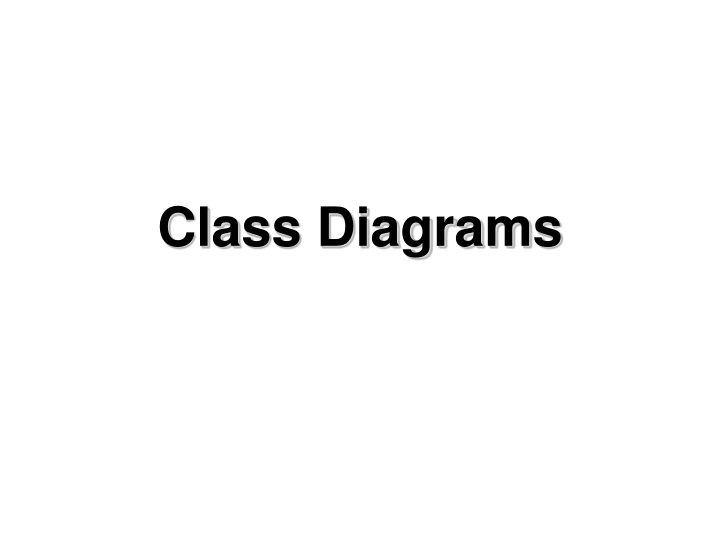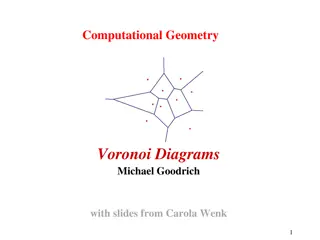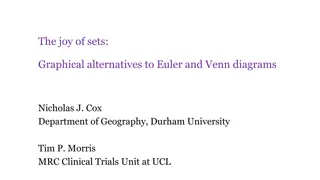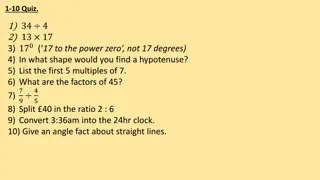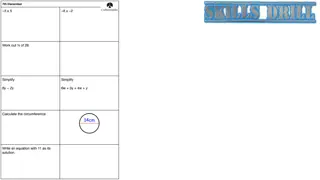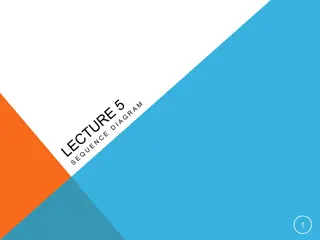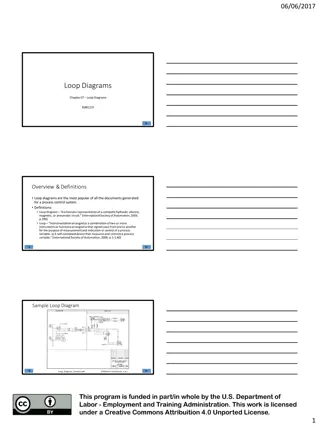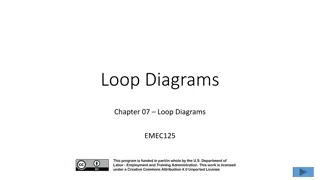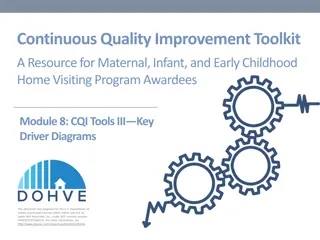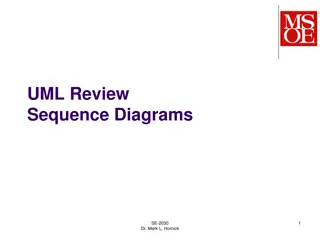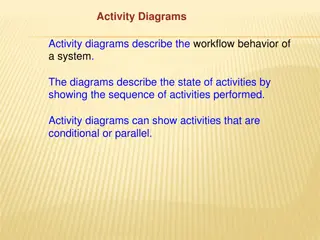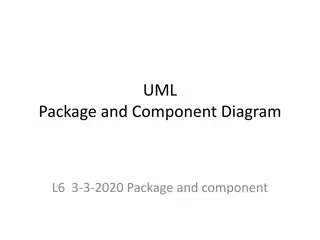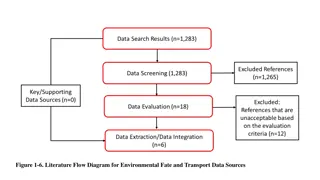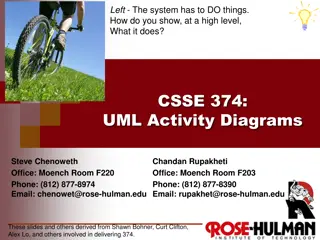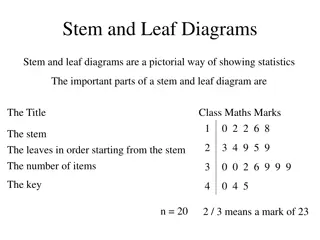Class Diagrams
Explore the basic syntax, semantics, and details of class diagrams in software engineering. Learn about associations, inheritance, class icons, attributes, methods, comments, and more to effectively represent classes and relationships in object-oriented programming. Dive into abstract classes and their implementations, as well as practical examples of class diagrams in action.
Download Presentation

Please find below an Image/Link to download the presentation.
The content on the website is provided AS IS for your information and personal use only. It may not be sold, licensed, or shared on other websites without obtaining consent from the author.If you encounter any issues during the download, it is possible that the publisher has removed the file from their server.
You are allowed to download the files provided on this website for personal or commercial use, subject to the condition that they are used lawfully. All files are the property of their respective owners.
The content on the website is provided AS IS for your information and personal use only. It may not be sold, licensed, or shared on other websites without obtaining consent from the author.
E N D
Presentation Transcript
Class diagram basic syntax Association name Class name Class name Attributes Methods Component This is a superclass aggregation Aggregate Class name specialization Class name This is a subclass Attributes Methods comments
Class Diagram - semantics A class icon must have a class name. Optionally, it can have attributes and/or methods. Attributes and methods are strings and will not be validated by the modeling tools. Attributes can be specified by their names or by <name : type> pairs. Methods can be specified by their names or with partial signatures or with complete signatures.
Class Diagram basic syntax (continued) Comments can be included in any diagram with a rectangle folded at right top corner The dotted line from the comment is important to indicate which portion of the diagram is explained by the comment Suggestion For verification purposes, when showing aggregation relationship, the aggregate (the one near the diamond edge) must include an attribute whose type is the component class
Details of a class icon Account Initial value - Account number : Integer - Balance : Real - Overdraft : Boolean = true + GetAccountNumber () : Integer + public # UpdateBalance (sign : Sign, amt : Integer) - private ~ ReturnBalance () : Real # protected -ChangeOverdraft () ~ visible within the package
Another view of the same class Account Private: Account number : Integer Balance : Real Overdraft : Boolean = true Initial value Public: GetAccountNumber () : Integer Protected: UpdateBalance (sign : Sign, amt : Integer) Package: ReturnBalance () : Real Private: ChangeOverdraft ()
An abstract class Polygon {abstract, author = Kasi, last modified = Oct 2002} <<constructor>> + Polygon(List of Vertex vertices) <<query>> #area () : Real
ATM class diagram Account Accounts Datatable - Account# : Integer - UserID : Integer - Balance : Double + getBalance() : double + verifyUser (actnum, uid) : Boolean + deposit (amt) + withdraw (amt) - Accounts : Account[] + addAccount (account) + deleteAccount (acct#) + searchAccount (acct#) + updateAccount (acct#) 1 uses Login Accounts Datatable 1 - Accounts : Login Account[] Login Account + addAccount (account) - UserID : Integer + deleteAccount (uid) - Password : String + searchAccount (uid) + changePassword (str) + updateAccount (uid)
Item Library Title : String CallNumber : String Books : Book[] Loans : BorrowItem[] Periodicals : Periodical[] Users : Borrower[] Book addBook : (b : Book) addPeriodical (p : Periodical) searchBook (callno : String) : Book searchPeriodical (callNo : String) : Periodical addUser (u : Borrower) deleteUser (id : String) searchUser (id : String) : Borrower loanItem (u : Borrower, b : Book) addBorrowItem (bi : BorrowItem) deleteBorrowItem (callNo : String) calculateFine() payFine (u : Borrower) Periodical Author : String YearOfPublication : Integer Volume : String Issue : String Year : Integer BorrowItem BorrowerID : String DueDate : Date Borrower ID : String BooksBorrowed : BorrowItem[] Fine : Double
Association syntax Association label Direction of association uses customer Account User 1 -Account number -Balance -Overdraft n Manager 1 cardinality +Get accountID () Role names +Update balance() {xor} +Return balance() Unary association Corporate Account n
Association - Semantics Every association is expected to be labeled UML does not require a name for an association Direction of an association, cardinality, role name are all optional For unary associations, it is better to include role names Representations of cardinality 0, 1, * (zero or more), n..m (values in the range between n and m both inclusive)
Association Semantics (continued) A constraint may be [optionally] placed between two associations See the example in the previous slide that asserts an Exclusive OR relationship between the associations When a subclass specializes a superclass, it also inherits all associations between the superclass and other classes In the previous example, the association uses between User and Account is also inherited by the pair User and Corporate Account
Association with qualifiers uses Account Account number User 1 -Account number -Balance -Overdraft n +Get accountID () Qualifier attribute +Update balance() Qualifier +Return balance() Corporate Account
Association - Qualifiers Qualifiers can be attached to a one-to- many association It is rectangle attached to the many end of the association A qualifier is a collection of variables whose values uniquely identify an instance at the many end of the association In the example, an account number uniquely identifies an account in a collection of accounts Qualifier is part of the association
Association Class User Account Transaction Job Employee Salary
Association Class - semantics A piece of information that belongs to both classes in an association is put into a separate class called association class Association class is a dependent class that depends on the other two classes in the association An association class cannot exist independently An object of an association class must refer to objects of the other two classes in the association Example: A Transaction object depends on a User object and on an Account object.
Shared Aggregation An aggregation relationship in which the component can be shared by classes/objects outside the aggregation Team Person Family Person object is shared by both Team and Family objects Shared aggregation is indicated by a hallow diamond Caution: Changes made to a component object will affect all the aggregates that include the component.
Composite Aggregation An aggregation relationship in which the component is an exclusive part of the aggregate; hence, not shared. Wing 2 1 Air Plane 1 2 Engine Composite aggregation is indicated by a filled diamond
Advanced Specialization Person Gender Sports activity {complete, disjoint} {incomplete, overlapping} Boy Girl Swimmer Runner These optional domain words make the relationships easier to understand.
Exercise 1 Extend the library class diagram to include the following: Borrowers can now reserve books. No periodical can be reserved. A book can be reserved only when a borrower wants to borrow that book but it is loaned to another borrower need some status variable for books.
Exercise 2 Redesign the classes in Exercise 1 so that the classes Borrow Item and Reservation are now designed as Association classes.
